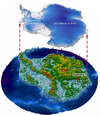Liliea
Jedi Council Member
Under the Antarctic ice, an immense hidden landscape
THE OCT 24, 2023 AT 4:04 P.M. (UT). Oct 26, 2023 at 6:02 a.m. (UT)AFP. By Daniel LAWLE. © 2023 AFP
A setting frozen in time: scientists have detected a vast landscape of green hills and valleys, hidden for millions of years beneath the Antarctic ice, according to a study published on Tuesday.
This landscape, larger than Belgium, is thought to have remained intact for potentially more than 34 million years, but could be freed by melting ice due to global warming, warn the British and American researchers behind the discovery.

"This is an undiscovered landscape that no one has ever laid eyes on," Stewart Jamieson of Britain's Durham University, lead author of the study published in Nature Communications, tells AFP.
The researchers didn't need any new data to detect it, but simply used a new approach to this terra incognita, located beneath the East Antarctic ice sheet, far less well known than the surface of Mars.
To see what lurks beneath, it was necessary to send radio waves into the ice, overflown by plane, and then analyze the echoes, a technique known as radio-echographic sounding.
But carrying out this operation on the scale of the Antarctic continent - larger than Europe - would be a major challenge. The researchers therefore used existing satellite images of the surface to "trace valleys and ridges" at depths of over two kilometers, explained Stewart Jamieson.
Combining this data with that from the radio echo sounding, a picture emerged of a river-carved landscape of deep valleys and steep-peaked hills, similar to those found on the Earth's surface today.
"It was like looking out of an airplane window and seeing a mountainous region below," deciphers the glaciologist, who compares this landscape to the Snowdonia region of North Wales.
Climate threat
This 32,000 square kilometer expanse was once home to forests and probably animals. Before the ice covered it, "freezing it in time".
It's hard to say exactly when the landscape was last exposed to the sun, but estimates suggest it was at least 14 million years ago. Prof. Jamieson's "hunch" is that it happened over 34 million years ago, when Antarctica began to freeze over.
Researchers had previously found a city-sized lake under Antarctic ice, and the study's authors hope to unearth even more landscapes.
Except that global warming could threaten their latest find.
Fortunately, the landscape lies miles from the edge of the ice cap, which should protect it from future exposure to light.
Another reassuring parameter is that this hidden world has not been affected by the retreat of ice during earlier periods of warming - such as the Pliocene period 3 to 4.5 million years ago.
But we still don't know what the climatic "tipping point" will be for an "uncontrolled reaction" of melting ice, stresses Prof. Jamieson.
On Monday, a study warned that the melting of the nearby West Antarctic ice sheet could accelerate dramatically in the coming decades. Even if the world respects its commitments to limit global warming.
Translated with DeepL

Prof. Jamieson Stewart
My research focuses on understanding controls on ice sheet behaviour, long-term landscape evolution, topographic reconstruction and glacial geomorphology. In particular, I am interested in understanding and quantifying the impact that interactions between these large-scale processes have upon ice sheet behaviour. Geographically, my work centres upon Antarctica although I also have interests in Greenland, Norway, Canada, Patagonia and the Himalayas.
I use an approach that links numerical models of ice sheets, ice streams, tectonics and rivers to geological and geomorphological evidence for past system behaviour. A significant component of my model-based research is carried out using synthetic systems to understand the responses of ice sheets and ice streams to perturbations in bed conditions produced under conditions of glacial erosion and deposition.
My current project investigates the importance of glacial erosion and deposition for controlling the advance and retreat of marine-terminating ice streams. This builds upon a major component of my previous work which focused on determining how patterns of glacial landscape evolution under terrestrial ice sheets can perturb ice dynamics on timescales of hundreds to millions of years.
Long-term landscape evolution of Antarctica
Much of my work has focussed on understanding patterns of long-term landscape evolution in Antarctica. By making links between numerical models of ice behaviour and our knowledge of landsystems that were produced under ice in the Northern Hemisphere, I have been able to predict how Antarctica has been modified by its long-lived ice sheet. This has led to better understanding of long-term interactions between ice and the landscape in Antarctica. Read more.I am also working on using our understanding of glacial erosion processes and patterns to reconstruct the former landscape of Antarctica. This work forms part of theANTscape project to generate a range of palaeotopographic maps of Antarctica over the past 130 Million Years (www.antscape.org). This work is sponsored by Past Antarctic Ice Sheets (PAIS) group of the Scientific Committee on Antarctic Research (SCAR).
